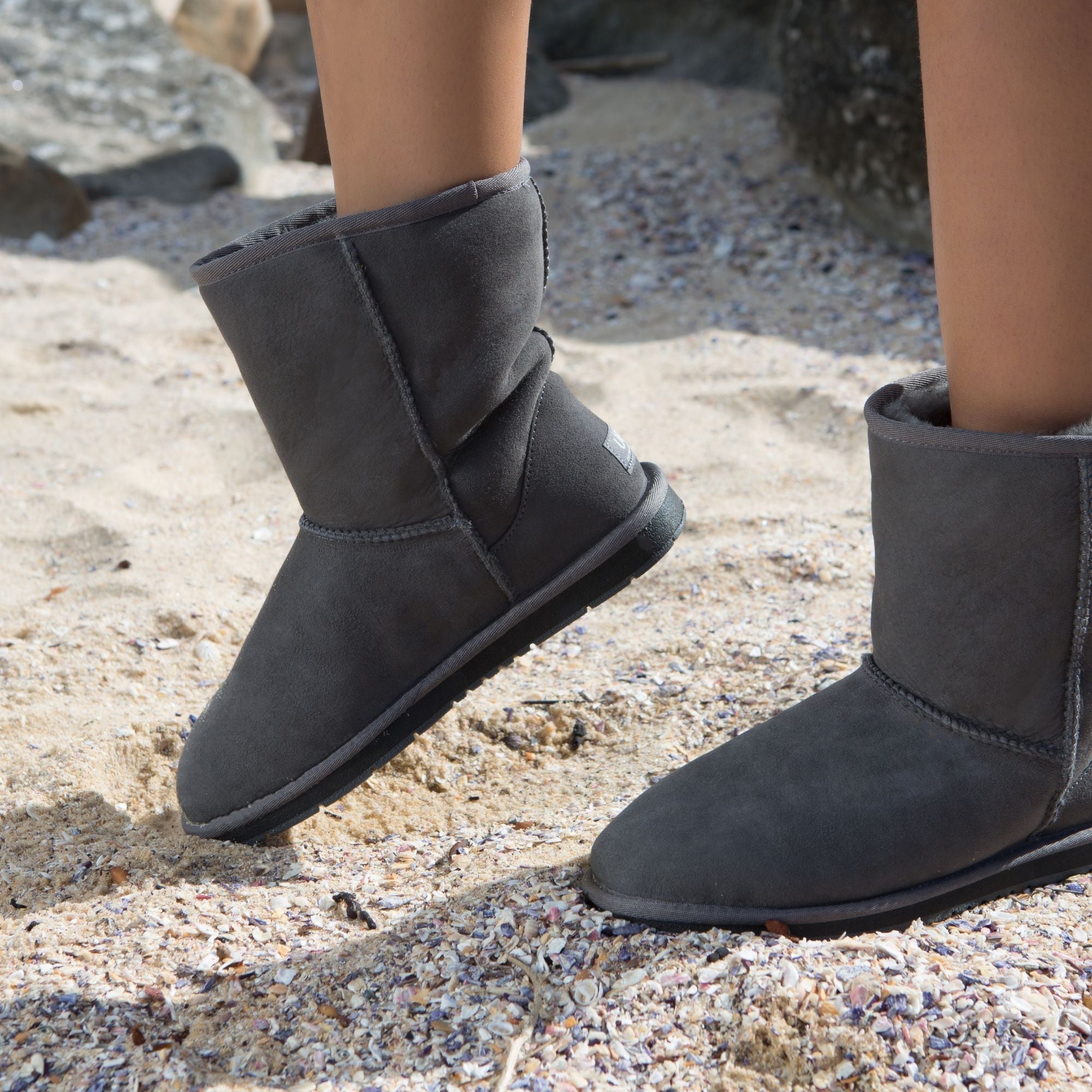Love UGGs but Curious About Zero-Drop? Read This First
If you’ve been wearing UGGs for years, it’s easy to assume they’re good for your feet — they’re soft, warm, and ridiculously comfy. But if you’ve started hearing about “zero-drop” shoes and natural foot health, you might wonder if your favourite boots hold up.
Here’s the truth: UGGs feel great, but that doesn’t automatically mean they’re helping your feet in the long run, especially if you’re trying to move toward barefoot-style or zero-drop footwear.
This article isn’t about bashing UGGs or making you feel guilty for loving them. It’s about helping you understand what zero-drop actually means, how UGGs fit into that picture, and what to expect if you keep wearing them while shifting to a more foot-friendly setup.
Let’s clear things up so you can make confident, informed choices — without ditching your UGGs cold turkey.
What Does “Zero-Drop” Actually Mean?
Before we talk about UGGs, it helps to understand what zero-drop really means, because it’s not just a buzzword.
“Drop” refers to the difference in height between the heel and the toe of a shoe. Most mainstream shoes, including trainers, boots, and yes — UGGs — have a raised heel. That lift might be subtle, but it shifts your body’s alignment forward and changes how your feet and muscles work.
A zero-drop shoe, on the other hand, means your heel and forefoot are on the same level. No elevation. No tilt. Just flat, like standing barefoot on the ground. The idea is to allow your body to move in a more natural, balanced way, helping with posture, reducing unnecessary strain, and encouraging better foot mechanics.
It’s not just about the drop, though. A true zero-drop shoe also tends to have:
-
Minimal cushioning so that you can feel the ground better,
-
Wide toe boxes, so your toes can spread naturally,
-
Flexible soles, so your feet can move the way they’re designed to.
Are UGGs Zero-Drop? Let’s Break It Down
Let’s not dance around it — UGGs are not zero-drop. But the way they feel can be misleading, so let’s unpack why.
Heel Elevation
UGGs have a slight heel rise — not as noticeable as in some boots or running shoes, but it’s there. Even a small lift shifts your centre of gravity forward, affecting how your ankles, knees, hips, and spine align when you walk or stand.
Thick, Cushy Soles
That marshmallow-like sole? Super comfy, but it’s doing a lot of the work your foot muscles should be doing. This much squish can throw off your foot’s ability to sense the ground, which can mess with balance and natural gait — the very things zero-drop aims to restore.
Narrow Toe Boxes
Your toes need room to splay out with every step. UGGs, especially the UGG classic boots, tend to taper in. It’s subtle, but over time it can restrict toe movement and even contribute to issues like bunions or hammertoes — the opposite of what minimal footwear is trying to prevent.
Stiffness and Structure
While UGGs feel soft on the inside, the sole itself is actually pretty stiff compared to flexible, barefoot-style shoes. That limits natural foot movement and reinforces a passive walking pattern.
In short: UGGs tick the comfort box but miss the mark on zero-drop principles — flatness, flexibility, and natural movement.
The Hidden Trade-Offs of That ‘Cloud-Like’ Comfort
We all love that plush, sink-in feeling you get when you slip on a pair of UGGs. But here’s the catch: what feels good in the moment isn’t always what your body needs long-term, especially if you're aiming for a more natural, zero-drop approach to movement.
Soft Doesn’t Mean Supportive
UGGs cushion your foot, sure. But all that squish can dull the feedback your feet get from the ground — something your body actually relies on for balance, posture, and muscle engagement. Over time, this can lead to weak foot muscles and poor alignment, because your body’s constantly over-correcting for what it can’t feel.
You Might Be Outsourcing the Work
Think of your foot like a suspension bridge — made to flex, absorb shock, and adapt. When a shoe does all that for you, your foot stops doing its job. That can lead to collapsed arches, tight calves, or even knee and hip discomfort, especially if you're also spending time barefoot or in zero-drop shoes that expect your feet to pull their weight.
Comfort Can Be a Crutch
When something feels “safe” and cosy, you’re more likely to wear it longer, even if it’s working against your goals. UGGs might be your go-to around the house, but if you're also trying to strengthen your feet, improve your posture, or transition into more minimal footwear, they might be quietly undoing your progress.
None of this means UGGs are evil. But if you’re trying to shift toward a more natural, zero-drop setup, it’s worth knowing what you’re trading for that instant comfort.

Wearing UGGs in a Zero-Drop Lifestyle: What to Expect
So you’re switching to zero-drop shoes for posture, mobility, foot strength, or just to feel more grounded. But you’re still slipping on your UGGs at home or running errands. What happens then?
Here’s what to expect if you mix UGGs with a zero-drop lifestyle.
Mixed Signals for Your Body
Zero-drop shoes encourage a neutral posture and activate muscles in your feet, legs, and hips that might’ve been asleep for years. UGGs, with their slight heel and soft base, send the opposite message. Your body ends up bouncing between two movement patterns, which can slow your progress or cause tension as it constantly readjusts.
Weaker Foot Engagement
If you’ve been working to build up your foot strength (which is key in zero-drop shoes), UGGs can undo that work without you realising it. All that cushioning takes pressure off the muscles you’ve been trying to wake up, especially your arches, toes, and ankles.
Posture Gets Thrown Off
Zero-drop shoes help stack your posture: head over shoulders, shoulders over hips, hips over feet. Even a small heel lift (like what’s in UGGs) tips your body forward. Over time, this can lead to tight calves, lower back tension, and the kind of hunched stance you’re likely trying to leave behind.
It’s Not Just About Your Feet
Your feet are the foundation for everything above them. So even if you’re only wearing UGGs for a few hours here and there, they can have knock-on effects — especially if your body’s still adapting to zero-drop.
What to Do if You Love UGGs but Want to Go Zero-Drop
Let’s be honest — UGGs are hard to quit. They’re cosy, familiar, and easy to slip on. So if you’re trying to move toward a zero-drop lifestyle but still want to hang onto them, you’re not alone. Here’s how to do it without sabotaging your progress.
Be Strategic With When You Wear Them
Use your UGGs like you’d use a pair of slippers — short-term comfort, not all-day wear. Lounging on the couch or walking to the mailbox? Fine. But if you’re on your feet for hours or walking long distances, choose something more foot-friendly.
Offset UGG Time With Barefoot Time
Balance is everything. If you’ve worn your UGGs all morning, spend the afternoon barefoot (on safe surfaces) or in proper zero-drop shoes to re-engage your muscles. Think of it like a reset button for your posture and feet.
Consider Barefoot-Inspired Alternatives
There are now minimalist, zero-drop boots and slippers that look and feel similar to UGGs, just without the heel lift and restrictive shape. Brands like Lems, Be Lenka, and Wildling Shoes offer wide-toe, flat, and cosy options that won’t compromise your alignment.
Modify, if You’re Keen
If you're really attached, you can hack your UGGs. Some people remove the insole (which adds to the heel rise) and replace it with a flat, thin insert. It won’t be perfect — the sole will still be stiff, but it brings the drop closer to neutral.
Listen to Your Body
If you notice your calves are tight, your arches ache, or your posture feels off after wearing your UGGs, don’t ignore it. Those signals mean it might be time to reduce how often you wear them or look for something that better supports your goals.
The key here isn’t all or nothing. It’s making intentional choices based on what your body needs, not just what feels nice in the moment.
You Don’t Have to Ditch Your UGGs — Just Use Them Smarter
If you’ve made it this far, you’re clearly thinking about your feet in a more intentional way, and that’s a good thing.
This isn’t about saying UGGs are “bad” or that you need to throw them in the bin. It’s about knowing what you’re getting when you wear them, especially if you’re also trying to build strength, improve posture, or move more naturally through zero-drop shoes.
UGGs are warm and comfortable — no one’s denying that. But comfort doesn’t always mean alignment, and softness doesn’t always mean support. Once you know the trade-offs, you can decide when and how they fit into your lifestyle, without undoing the good work you’re doing for your body.
So no, you don’t have to choose between your UGGs and your foot health — but you do need to be aware of how they interact. Make smart, balanced choices, and your feet (and everything above them) will thank you.
If you’re looking to update your pair or find something cosy to wear in moderation, check out the latest UGGs at UGG Originals — comfort, warmth, and classic design, straight from the source.


